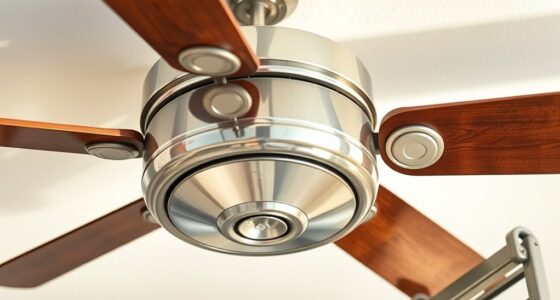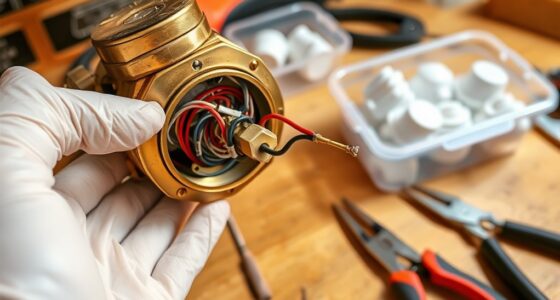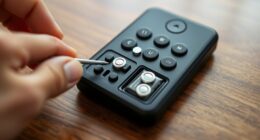To dismantle and recycle a ceiling fan safely, first disconnect the power supply and wear safety gear. Remove the fan blades, light kit, and mounting bracket carefully, organizing screws for reuse. Disconnect wiring harnesses and detach the motor from the ceiling mount. Separate components like the motor housing and internal parts for recycling, sorting plastics, metals, and electronics. Follow local regulations for disposal and explore efficient recycling methods—further details guarantee you maximize eco-friendly practices.
Key Takeaways
- Turn off power, disconnect wiring, and safely remove fan blades, light fixtures, and mounting bracket before dismantling.
- Detach the motor from the ceiling mount, preserving wiring for recycling or disposal.
- Separate the motor housing, blades, and other components, labeling parts for organized recycling.
- Sort metals, plastics, and electronic parts, following local recycling regulations for proper disposal.
- Clean and prepare recyclable materials, then deliver them to appropriate recycling facilities to minimize environmental impact.

Dismantling and recycling a ceiling fan requires careful planning and adherence to safety protocols to guarantee proper disposal and material recovery. Before beginning, ensure you have the necessary tools: a screwdriver (flat-head and Phillips), pliers, wire cutters, and possibly a voltage tester. Wear protective gear, including gloves and safety goggles, to prevent injury from sharp edges, electrical components, or moving parts. Confirm the power supply is disconnected by turning off the circuit breaker and testing the wires with a voltage tester. This step eliminates the risk of electric shock during disassembly.
Always disconnect power and wear safety gear before dismantling a ceiling fan.
Start by removing the fan blades. With the fan stationary, unscrew the blade brackets from the motor housing using your screwdriver. Keep the screws organized for potential reuse or recycling. Once the blades are detached, carefully remove the fan’s light kit if present, disconnecting any wiring connectors with pliers, and store or recycle these components separately. Next, locate the mounting bracket securing the fan to the ceiling. Unscrew the bracket from the electrical box, supporting the fan’s weight as you do so. Lower the entire fan assembly carefully, ensuring no wires or parts are strained or damaged during removal.
With the fan down, disconnect the wiring harness from the motor and ceiling wires. Use wire cutters to trim any excess wiring, leaving appropriate lengths for recycling or disposal. Remove the fan motor from the mounting bracket by unscrewing bolts or nuts, following manufacturer specifications. The motor housing contains electrical and metal components, which can be separated later for more efficient recycling. Additionally, understanding the contrast ratio of the motor and other components can help in assessing their quality for recycling purposes.
Disassemble the remaining parts, such as the fan’s downrod, light fixtures, or decorative covers, by unscrewing and detaching components. For the motor, identify the internal parts—such as the armature, brushes, and bearings—that can be separated and processed accordingly. The motor casing, usually metal, and internal components can be recycled at metal facilities. The plastic and electronic parts should be sorted for recycling through electronic waste channels.
Throughout the process, maintain proper disposal of non-recyclable parts, such as certain plastics or damaged components. Segregate metal, plastics, and electrical parts into designated recycling streams, complying with local regulations. After dismantling, clean the recyclable materials of any residual debris to ensure they meet recycling facility standards. Proper separation and documentation facilitate efficient recycling, minimizing environmental impact and recovering valuable materials like metals, plastics, and electronic components. Following these precise steps ensures a safe, effective dismantling process aligned with best practices for recycling ceiling fans.
Frequently Asked Questions
Can I Dismantle a Ceiling Fan Without Turning off the Power?
No, you should never dismantle a ceiling fan without turning off the power. Doing so risks severe electrical shock or injury. Always switch off the circuit breaker and verify power is off using a voltage tester. confirm the fan is completely de-energized before proceeding with removal or dismantling. Safety precautions are essential to prevent accidents and ensure a safe dismantling process.
What Tools Are Essential for Safely Dismantling a Ceiling Fan?
You need a screwdriver, pliers, and a voltage tester to dismantle a ceiling fan safely. For example, if you’re removing a fan from a living room, test the wires first with the voltage tester to confirm no power runs through them. Use the screwdriver to detach blades and mounting hardware, and pliers for grip and removal of wire nuts. Always verify power is off before starting any work.
How Do I Identify Recyclable Parts of a Ceiling Fan?
You can identify recyclable parts of a ceiling fan by inspecting its metal blades, motor housing, and metal mounting hardware, which are typically made of steel or aluminum. The electrical components, such as wiring and switches, contain copper and other metals that are recyclable. Plastic blades and non-metallic parts are usually non-recyclable. Separate metal parts from non-metallic ones carefully, and dispose of plastic components according to local recycling guidelines.
Is It Necessary to Disconnect the Fan From Electrical Wiring First?
Yes, you must disconnect the fan from electrical wiring first. Turn off the power supply at the circuit breaker to guarantee safety. Confirm the fan is de-energized using a voltage tester before proceeding. Disconnect the wiring connectors carefully, noting wire colors and connections for reference. This step prevents electrical shock and allows safe dismantling. Always follow safety protocols and consult local electrical codes when handling electrical components.
Are There Safety Precautions Specific to Certain Ceiling Fan Models?
Like traversing a minefield, you must heed model-specific safety precautions. Some fans feature delicate wiring or integrated sensors requiring gentle handling. Always consult the manufacturer’s manual to identify unique warnings, such as avoiding certain tools or procedures. Wear insulated gloves and safety goggles, especially with fans that have exposed wiring or fragile components. Properly disconnect power before starting, and make certain you’re well-versed in each model’s nuances to prevent accidents.
Conclusion
By carefully dismantling your ceiling fan, you guarantee safe removal and effective recycling of materials. Always remember, a job done properly is a job done once. Proper disassembly not only minimizes environmental impact but also maximizes the potential for reuse of parts. Handle components with care, follow safety guidelines, and dispose of or recycle responsibly. In the end, taking the time to do it right reflects a commitment to sustainability—because a responsible homeowner leaves a better world behind.








